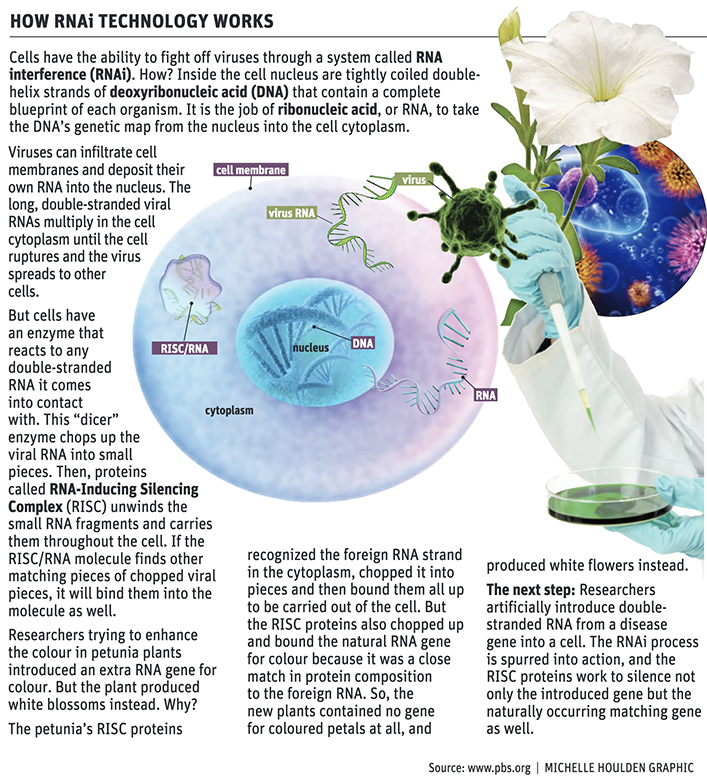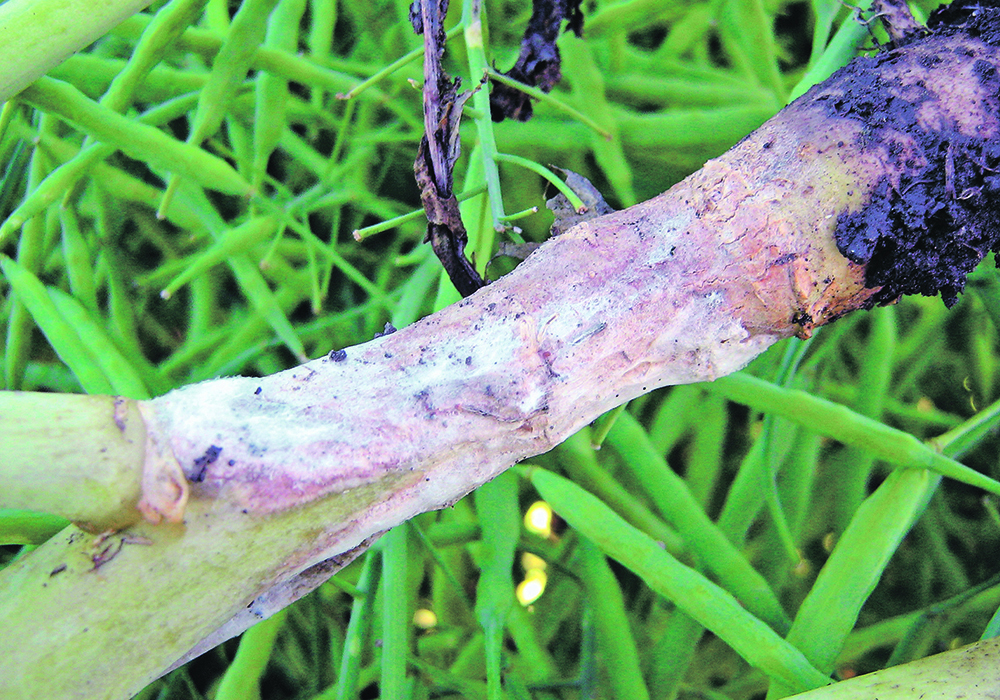Mark Belmonte knows it takes years or decades to get plant science discoveries to market in Canada.
Despite that, Belmonte remains optimistic that his research on RNA interference and controlling crop pests could eventually make a massive difference for growers in Canada and around the world.
“There’s a tremendous amount of potential here… (for) applications that really cut across all of agriculture,” said Belmonte, a University of Manitoba plant science professor, who runs the Belmonte Lab at the university.
For years, he and his team have been developing a “next generation molecular fungicide” to control sclerotinia (white mould), a major disease in canola and dozens of other crops.
A molecular fungicide is another name for technology known as RNA interference, RNAi or gene silencing. In the simplest terms, scientists create a molecule — a double stranded RNA — that silences an important gene in a pest and shuts down production of a target protein in the pest.
A 2022 paper by Belmonte and others, published in PLOS One, provides a short explanation of the approach.
“RNAi-based crop protection technologies can be designed in two ways. First, through a topical approach where the double stranded RNA is applied as a spray,” it said.
“Second, through genetic modification of the host plant to produce… dsRNA molecules targeting the pathogen…. Both methods have proven effective at limiting infections and disease symptoms of various fungal pathogens.”
Other researchers and companies are also moving ahead with RNAi to control crop pests. A Vancouver company, Renaissance Bioscience, has developed an RNAi biopesticide that killed more than 98 percent of Colorado potato beetles in tests.
“These are very promising results clearly showing that Renaissance’s environmentally safe technology protected the potato plant from the Colorado potato beetle,” Renaissance chief executive officer John Husnik said in a 2021 news release.
In mid-February, at a conference in Winnipeg, Belmonte summarized his lab’s research into RNAi and sclerotinia.
“We’re at the early field stage trials for the spray application,” he said. “We’re seeing some really encouraging results.”
During his presentation, Belmonte showed photos of canola leaves infected with sclerotinia lesions and some without lesions. The ones without lesions, or smaller infections, were treated with a dsRNA spray.
“These sprays are great because we can apply them in a similar way to traditional fungicides,” he said.
“We’ve been able to slow down the infection enough (so) it gives the plant a fighting chance and (preserves) yield…. Sclerotinia is one of the (top) yield robbers of canola, all across Western Canada.”
Sclerotinia also affects dry beans, field peas, sunflowers, lentils, mustard and potatoes. Belmonte estimated the disease infects more than 500 crop species around the world.
Fungicides control the disease, but fungi are developing resistance to certain chemistries.
Having another option, such as a molecular fungicide, could be a difference maker for Canadian farmers.

Before that happens, Belmonte and his group must improve the formulation of the spray so it’s more resilient and performs in a range of environmental conditions.
They also need to prove to Health Canada that the technology is safe.
“Ensure the molecules we’re working with have no off-target (effects),” Belmonte said.
The molecules, or the dsRNA, are designed to shut down an important gene in the sclerotinia fungus, which is associated with a specific sequence of DNA.
Belmonte needs to show that other organisms, such as beneficial fungi in the soil, don’t have the same genetic sequence.
“It’s impossible to know that for every single organism… because not every single organism has a genetic database that’s (publicly) available,” he said.
“Some of the big ones we do. A lot of the plant pathogens, we do. A lot of beneficial fungi, we do. A lot of the beneficial pollinators, we do.”
The good news is that the molecule only persists for a short time in the environment, making off-target effects less likely.
“The field trials we have ongoing… what we found is the molecules will degrade within the soil within a matter of hours,” he said.
Belmonte and his team are collaborating with a major crop science company to commercialize the sclerotinia spray in Canada. The financial backing and regulatory knowledge will help, but it will still take at least five years to get the technology to market.
The U of M researchers are working on a different version of sclerotinia control. They have developed a transgenic canola with foreign DNA from sclerotinia. Like the spray, the technology silences specific genes in the fungus.
“Allow the plant to do the work for us,” Belmonte said.
The good news is that the transgenic canola provides better and more durable protection against the fungus.
The bad news is that it’s expensive to commercialize a transgenic crop in Canada.
“It costs over $100 million and it takes generally around a decade to get a trait like this (to market),” Belmonte said.
Despite the massive cost and the 10-year timeline, a major company in the seed and traits business is supporting the research.
“The partner we’re working with has great investments in canola,” Belmonte said.
“They also see that canola is susceptible to multiple different things that they have not been able to solve with traditional breeding strategies…. Sclerotinia has been one of those giant challenges, largely because there are so many factors responsible for (the disease).”
Following Belmonte’s presentation at the CropConnect meeting, a producer asked him if this technology could be used on verticillium stripe, another fungal disease of canola.
The answer is yes.
And, looking 10 to 15 years into the future, it’s possible that crops could be engineered with multiple forms of RNAi to protect against multiple insects and fungi.
“We have a sister project… looking at flea beetles,” he said.
“You might want to stack a molecule that targets sclerotinia with a molecule that targets flea beetles.”
















